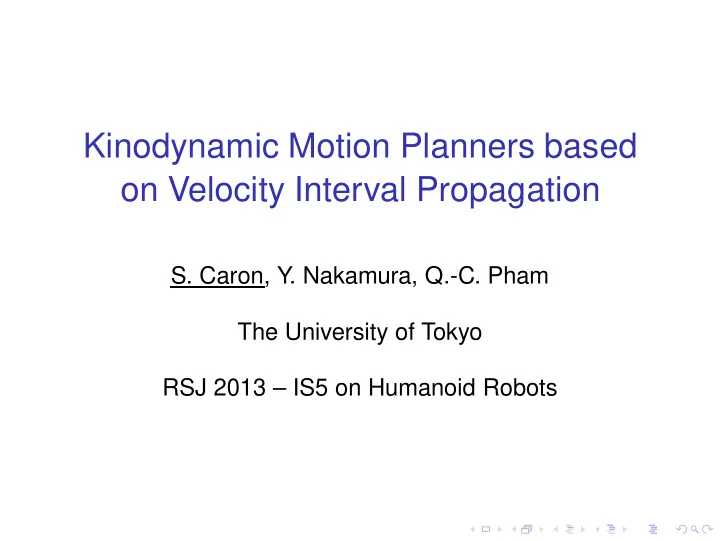

Kinodynamic Motion Planners based on Velocity Interval Propagation S. Caron, Y. Nakamura, Q.-C. Pham The University of Tokyo RSJ 2013 – IS5 on Humanoid Robots
Outline ◮ Reminder on Randomized Planning ◮ Admissible Velocity Propagation algorithm ◮ Preliminary experiments ◮ Towards humanoid robots...
Kinodynamic planning ◮ Non-holonomic constraint: q = f ( q , ˙ q , τ ) ¨ ◮ Torque constraints: for every joint i , | τ i | ≤ τ max i
Randomized motion planning ◮ Major algorithms: – Probabilistic Roadmap (PRM) – Rapidly-expanding Random Tree (RRT) ◮ Pro: probabilistic completeness guarantee (established for kinematic planning) ◮ Con: curse of dimensionality
goal x init
goal x' x init
goal x' steer(x, x') x init
goal x' x init
goal x' x init
Requirements ◮ Steering function steer ( x , x ′ ) : reachable state closer to x ′ ◮ Antecedent search: finding nodes to steer from In kinematic planning: ◮ steering: geometric interpolation ◮ antecedent: neighborhoods for a metric σ ( x , x ′ ) What about kinodynamic planning?
Steering ◮ Forward dynamics based (non-humanoid) [LaValle, 1998, Hsu et al., 2002] ◮ Optimal steering (non-humanoid) [Karaman and Frazzoli, 2011] ◮ Inverse dynamics based [Kuffner et al., 2002]
Steering with inverse dynamics? ◮ Previous approach: – interpolate a trajectory – apply some dynamics filter [Kuffner et al., 2002] ◮ Our approach: – interpolate a path – propagate reachable-velocity intervals [Pham et al., 2013]
Admissible Velocity Propagation ◮ AVP algorithm: extension of the Time-Optimal Path Tracking algorithm [Bobrow et al., 1985] ◮ Input: – path P ⊂ C free – interval of admissible velocities [ v init min , v init max ] ◮ Output: – is the path traversable? – interval of reachable velocities [ v end min , v end max ]
Planner integration ◮ Each node stores a state x and a velocity interval [ v min , v max ] ◮ Extension: interpolate a path, propagate admissible velocities v max Admissible velocity profile v min v max Velocity q end v min Path q init Configuration space
Space × time decoupling Random data S pace x goal x' init Velocity intervals Paths T ime . s 0 s Trajectory
Properties ◮ Initial path unchanged → collision checking ◮ Applies to second-order non-holonomic constraints: ZMP balance, torque limits, ... Figure: Screenshot from [Pham and Nakamura, 2012]
Preliminary experiments Double-inverted pendulum: ◮ Link: length l = 0 . 2 m ◮ Link mass m = 1 kg ◮ Statically-stable planning: | τ 1 | > 15 . 6 N.m ◮ Torque limits: | τ 1 | ≤ 8 N.m ∧ | τ 2 | ≤ 4 N.m
Simulation results
Towards Humanoids ◮ Extension to under-actuated systems: decoupling vector fields [Bullo and Lynch, 2001] ◮ Identifying actuator limits ◮ . . .
To be continued... ◮ Randomized kinodynamic planning for humanoids? ◮ Importance of steering and antecedent selection ◮ Our approach steering: path tracking with velocity interval propagation
Thanks for your attention!
Bobrow, J. E., Dubowsky, S., and Gibson, J. (1985). Time-optimal control of robotic manipulators along specified paths. The International Journal of Robotics Research , 4(3):3–17. Bullo, F. and Lynch, K. M. (2001). Kinematic controllability for decoupled trajectory planning in underactuated mechanical systems. Robotics and Automation, IEEE Transactions on , 17(4):402–412. Hsu, D., Kindel, R., Latombe, J.-C., and Rock, S. (2002). Randomized kinodynamic motion planning with moving obstacles. The International Journal of Robotics Research , 21(3):233–255.
Karaman, S. and Frazzoli, E. (2011). Sampling-based algorithms for optimal motion planning. The International Journal of Robotics Research , 30(7):846–894. Kuffner, J. J., Kagami, S., Nishiwaki, K., Inaba, M., and Inoue, H. (2002). Dynamically-stable motion planning for humanoid robots. Autonomous Robots , 12(1):105–118. LaValle, S. M. (1998). Rapidly-exploring random trees a new tool for path planning.
Pham, Q.-C., Caron, S., and Nakamura, Y. (2013). Kinodynamic planning in the configuration space via velocity interval propagation. Robotics: Science and System . Pham, Q.-C. and Nakamura, Y. (2012). Time-optimal path parameterization for critically dynamic motions of humanoid robots. In IEEE-RAS International Conference on Humanoid Robots .
Recommend
More recommend